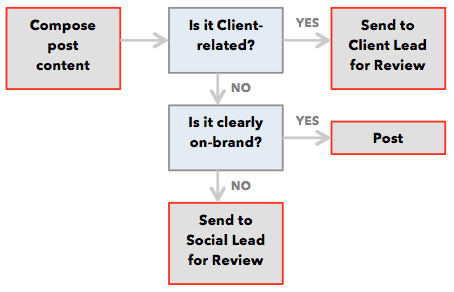Table of Contents
These days, it’s rare to find a business with social accounts that are managed by just one person. Although one person is generally responsible for making sure a strategy is in place and implemented consistently, if you want your social accounts to represent the different facets of what you do, you’ll need content from people on the ground – from the people interacting with customers, organizing events, volunteering, representing the business at trade shows and conferences, making products, etc. No social media manager can be in all those places at once, and so they find ways to gather shareable content from others.
The challenge of representing different aspects of an organization on social media, while staying on brand and on message, is an exercise in balance. If you allow anyone to contribute to your organization’s social accounts, things can quickly get off-message, or feel inconsistent in voice and tone. On the other hand, if you heavily restrict who contributes, the feeds become monotonous and predictable.
In this post, I’ll share some sustainable ways to spread the work of producing social content to a larger group, while presenting a coherent, relatable brand to your audience.
People will contribute if they know what’s expected
The most important thing we’ve found that encourages team members to help with social content is clarity in a number of areas:
Voice, tone, and message
Although social content may be generated by multiple authors, you want to present a consistent Brand Personality across social accounts (and throughout your other brand collateral, of course). A proven way to do this is to create strong editorial standards, and educate your team on them. Should posts be playful? Professional? Traditional? Edgy? What topics do you care about—community events? Industry news? What topics do you want to avoid? How does this differ across your different social accounts? All of this helps shape your social personality. For example, here’s an excerpt from our Editorial Guidelines:

These standards won’t be created from scratch – they should be a direct translation of your Brand Story and Personality for the online space. You’ll want to determine your voice and tone, as well as subject matter. This gives people an idea of “who to be” when they are representing your organization online, and gives approvers a set of criteria on which to base their approvals. Editorial standards are also key for your website content, and if you have any kind of online presence, they will make all content creation much smoother.
If you don’t have a good idea of what your Brand Story is, we highly recommend investing in a brand introspective process, such as a Brand Assessment. It will give you the tools to present a consistent Brand Story in all your organization’s interactions – from print and digital advertising, all the way to training employees in customer or member service, and is an integral part of creating brand loyalty.
Process
Clear roles put people at ease. How should social content be submitted? What approvals are required, and by whom? The answers to these questions will be tailored to your particular organization. For instance, we have a loose approval process for office or team updates, but any post that involves a client needs to be first approved by the appropriate Client Lead.
Gravity’s Simplified Approval Process

Reasonable safeguards
Approvals are one way of controlling content, but there are also measures that work well for more informal processes. Because team members sometimes post directly to our social accounts, we have a few key safeguards in place. For instance, whenever someone posts to our social accounts, the team gets that post as an email notification.* If there is an issue with the content, it can be addressed quickly. These notifications double as a way to encourage the team to like or share our company posts.
*Tools like Zapier can be extremely useful in creating automated text or email notifications for social activity.
People will contribute if it’s fun
Successful social content feels authentic, organic, and human. It’s hard to create authentic, organic content that has personality if you’re thinking about what kind of post will get the highest reach, or worried about getting in trouble for writing the wrong thing. In the end, good social management involves getting out of people’s way and just letting them be people. Here are some examples from Facebook of brands having fun, all of which could be staff-sourced. These are from national brands, but we’re sure you could do something just as good on your social pages.
Social cheerleading
On some level, social needs to feel fun, or people won’t contribute. Something as simple as regularly celebrating good content is enough to keep people excited about contributing. If someone comes up with a particularly good post, let them know how much you appreciate it. When we have team meetings, we enjoy looking over our recent social posts, and giving people credit for the great content they came up with.
Along with regular social cheerleading, there are some more structured ways to periodically drum up fun content: have informal contests within your organization to see whose post gets the highest reach or the most comments or shares; or challenge your team to make a video about why they love their job, and post the best ones.
Corrections
It’s important to be sensitive when giving negative feedback. If someone posts something that doesn’t quite gel with your brand and it gets taken down, be careful to make sure they understand why, and have the information they need to succeed next time. Social content can be hard to get right, and Editorial Standards evolve over time. They might appreciate knowing that their slightly off-brand post is useful, because it teaches you something really important about what’s on brand.
Keeping the strategy quiet
You’ll need someone to be responsible for making sure you’re posting regularly to social media, and running the numbers to see how your posts are doing. However, keep in mind that strategic thinking can put a serious damper on creativity and authenticity.
Someone needs to be thinking about strategy, but not necessarily while they’re writing a social post. If your team is contributing to social, you’ll want to be careful about how often you bring up strategy. They’ll need to be loosely aware of it, of course, but strategy can put a damper on good content if it’s too front of mind. For that reason, it can be good to occasionally talk about the numbers (reach, engagement, etc), but often it’s a good idea to simply celebrate content for how fun, or enjoyable it is, in your social cheerleading, rather than talking about how “effective” it was in reaching your audience.
Your turn
What strategies have you used to encourage collaboration across your social pages? Please add your voice in the comments!

